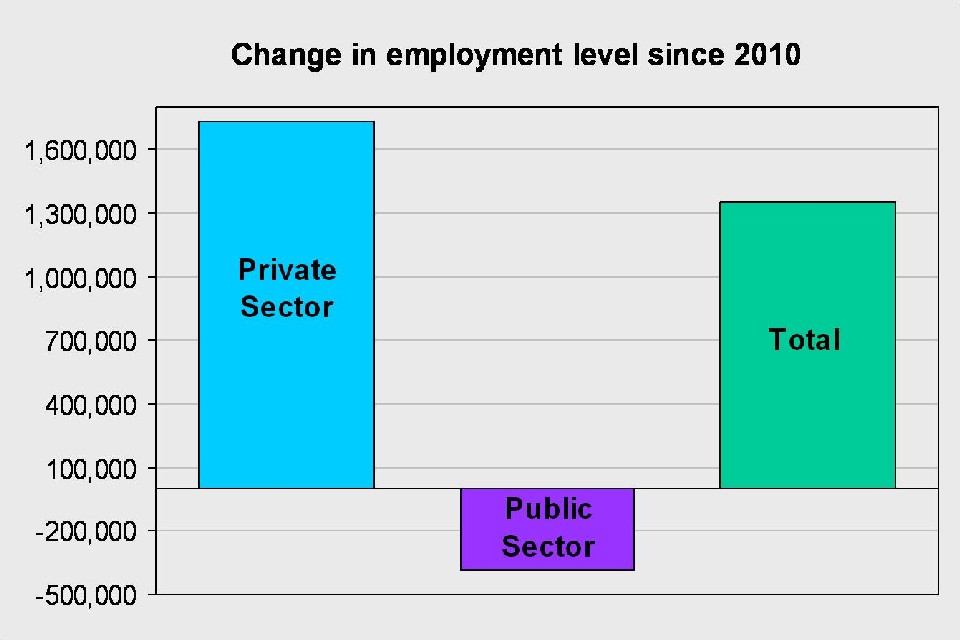Employment rate hits 5 year high fuelled by private sector growth
The employment rate has hit a 5 year high and a record 30.19 million people are now in jobs.

Private sector employment has increased by 1.73 million since 2010, showing the government’s long-term economic plan to back enterprise and businesses so they can create jobs is proving successful.

The number of people in work has increased by 1.35 million since 2010 – over a million of these jobs are full-time – and the employment rate is now 72.3%, the highest it has been since 2008.

Helping young people to get their foot in the door and progress in their careers is a priority for the government, and today’s figures also show that the number of young people in work increased by 43,000 in the last 3 months.
Employment Minister Esther McVey said:
We now have the highest employment rate for 5 years, which shows that the growing economy is helping record numbers of people to find a job, turn their lives around and have the security of a regular wage.
The rise in employment is being fuelled by businesses and entrepreneurs across the country who are feeling increasingly confident with the improving economy. They should be congratulated for creating over 1.7 million private sector jobs since 2010 – that’s over 1,000 more people in private sector jobs every day.
The number of people claiming Jobseeker’s Allowance (JSA) fell by over 363,000 on the year, which is the largest annual fall since 1998. The number of young people claiming JSA has been falling for the last 21 months.
The number of people who are unemployed fell by 63,000 in the last 3 months, with the number of people who have been unemployed for over a year falling by 38,000. The number of unemployed young people also fell by 29,000 and has been falling now for the last 6 months.
The latest figures also show the number of job vacancies increased in the last 3 months by 23,000 to 588,000.
Private sector pay (excluding bonuses) rose by 1.6%, which is the largest rise since October 2012.
Background to labour market statistics: March 2014
This month’s Labour Force Survey covers November 2013 to January 2014. The claimant count is for February 2014 and the vacancy count for December 2013 to February 2014.
The number of people in work rose this quarter
- 30.19 million people were in work in November 2013 to January 2014
- the employment level rose 105,000 on the previous quarter and 459,000 on the year
- the employment rate is 72.3%, up 0.2 points on the quarter and up 0.7 points on the year
ILO unemployment fell this quarter
- 2.33 million people were ILO unemployed in the November 2013 to January 2014 quarter, down 63,000 on the previous quarter and 191,000 on the year
- the ILO unemployment rate is 7.2%, down 0.2 points on the quarter and down 0.7 points on the year
The level of economic inactivity is down on the quarter and on the year
- the economic inactivity level is 8.90 million in the November 2013 to January 2014 quarter, down 19,000 on the previous quarter and 57,000 on the year
- the economic inactivity rate is 22.1%, down 0.1 points on the quarter and down 0.2 points on the year
- excluding students, inactivity as a share of the 16-64 population is 16.4%, unchanged on the quarter and down 0.3 points on the year
The number of people claiming one of the main out-of-work benefits is falling
- claimant unemployment was 1.17 million in February 2013, down 34,600 on the month and down 363,200 on the year
- the claimant count rate is 3.5%, down 0.1 points on the month and down 1.1 point on the year
- in the year to August 2013, the number claiming incapacity benefits fell 76,200 to 2.44 million – the most recent provisional figure for December 2013 suggests the caseload has risen slightly since then
- in the year to August 2013, the number of lone parents on income support fell 47,700 to 498,000 – the provisional figure for December 2013 is 485,000
The number of redundancies fell and unfilled vacancies rose on the quarter
- there were 117,000 redundancies in November 2013 to January 2014, down 2,000 on the previous quarter and 15,000 on the year
- the ONS vacancy survey estimates an average of 588,000 unfilled vacancies in the 3 months to February 2014, up 23,000 on the previous quarter and 92,000 on the year
Total weekly pay in January 2014 was up by 1.4% over the year
- growth in regular weekly pay, excluding bonuses, was 1.3% on the year
- growth in private sector regular weekly pay was 1.6% on the year
Universal Credit experimental statistics
The latest Universal Credit experimental statistics are also out today.
Contact Press Office
Media enquiries for this press release – 020 3267 5161
Press Office
Caxton House
Tothill Street
London
SW1H 9NA
Telephone: 0115 965 8781
Follow DWP on:
- Twitter – www.twitter.com/dwppressoffice
- Facebook – www.facebook.com/dwp
- LinkedIn – www.linkedin.com/company/dwp
- YouTube – www.youtube.com/dwp